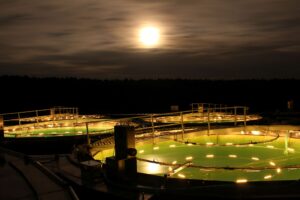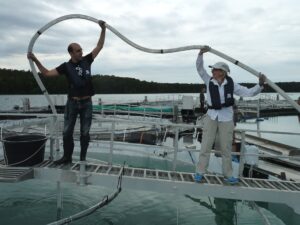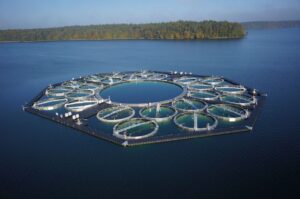The LakeLab at Lake Stechlin: Studying the impact of artificial light at night on aquatic ecosystems

Five o’clock in the morning. Lake Stechlin is dark and silent. Only a few lights are moving at the Old Fisherhut. The LakeLab scientists are getting ready to work.
We get into the boats, switch off our lights, and drive out onto the lake. After a few moments the eerie glow of the LakeLab becomes visible. We dock to the pontoon platform, get out and get organised. Big plastic containers and glass bottles are distributed, pipes and nets are brought into position. Time to start sampling.
I watch Matthias lower a pipe seven meters deep into one of the 24 enclosures. Carefully, he pulls the pipe back up. Jason collects the water in one of the big plastic containers. Chris fills the smaller bottles with water. Together they filter plankton into an extra bottle. Later, in the indoor lab, plankton species will be identified to find out which species can be found at that time of day in the upper water layers.
The LakeLab is a huge research platform of the Leibniz-Institute of Freshwater Ecology and Inland Fisheries. Funded mostly by the Federal Ministry of Education and Research, it has been built to study the physical, chemical, and biological effects of global environmental change on lakes. The enclosures are plastic tubes, with a diameter of nine meters each. Their walls go down into the muddy lake ground about 20 metres below us and seal up the enclosures from the lake. Each enclosure contains 1.250 m3 of water. They are giant test tubes in an amazing field laboratory.

Inside the enclosures is a controlled piece of the lake, even including fishes. One of them watches us during the afternoon, while Chris Kyba, a Canadian physicist from the German Research Center for Geosciences in Potsdam, explains to us how the sampling works and what can go wrong when you handle a nine meter pipe. We, that is me and Sara Pritchard, an environmental historian from Cornell University in the USA. She is here to research on how light pollution is studied.
This summer, the scientists are especially interested in how changes in the natural light regime, e.g. artificial light at night affect lakes. Not unlike human cities, there is daily commuting in the lake. Zooplankton spends the day in the lower water layers and rises to the surface under the cover of darkness. It then feeds on the algae that have grown and multiplied during the day thanks to sunlight and photosynthesis. But in the anthropocene, two factors might interfere with this daily migration. Artificial light at night has been shown to disturb the nocturnal rise of plankton by disguising the beginning of night (Moore et al. 2000). A contrary effect, a dimming of the lake, can be caused by humic substances, which are brought into the lake by the enhanced leaching of soluble substances from soils, a process linked to heavy rainfalls tending to increase during climate change.

The extend of these two factors are currently studied in the ILES project, short for Illuminating Lake Ecosystems. About seventy researchers from all over the world work here, biologists, physicists, mathematicians, engineers. All depend on each other to make the project work, so everyone works on other projects as well as on their own.
The enclosures are dimly illuminated. I watch with how much routine the scientists take their samples in the dark. The atmosphere on the platform is relaxed, friendly. People talk lowly, if at all. Everything is well rehearsed. Red light beams from head torches move around, sometimes the reflector stripes of a jacket flash in the dark. It’s another world out here, in the early morning on this silent lake.
It’s slowly getting brighter now, but the pontoon walkways are slippery from the constant drizzle. Yesterday, part of the preparation was to clean the walkways from the bird poop. The gulls like resting on the LakeLab and the ducks have discovered that no fox can get to them while they are on the platform. The birds are unwelcome guests. Not only is their poop a hazard for the scientists, it can also mess up the experiments.
Lake Stechlin is rather poor in nutrients, which is the reason for its clear water and makes it ecologically interesting. So it is important to control the amount of nutrients in the enclosures. Bird poop is rich in nutrients. The gulls and ducks could therefore feed the algae in the LakeLab to an unwanted extend.
Cleaning pontoons is one of the jobs that have to be done at the LakeLab, and it’s not exclusively done by the students. After having a turn myself, I watch Sara wielding the high-pressure cleaner. Chris and I joke about how many PhDs are needed to clean bird poop. No, not all scientific work is done in a clean and warm office.
It’s much nicer the next day, when we come out for one of the daylight samplings. Next to the boat’s landing place, the smaller bottles we have filled that morning have been lowered into the water. They will be collected in the afternoon to measure the photosynthetic activity of the phytoplankton in the different enclosures.
I watch how plankton is taken out of the lake when another group catches my eye. It’s the camera team. They are lowering a huge video-based probe into one of the enclosures to take pictures of all the little critters down there. Small dots, appear on the computer screen, sometimes a water flea or another alien looking creature. This is the zooplankton that feeds on the algae and is the beginning of the animal food chain. Later, a computer program will indentify all the life forms to get a census of the organisms in the lake.
The sampling of the ILES project will run until end of September 2018. Then it will take another 2-3 years until the results will be published. The researchers hope to get new information about how light pollution influences the aquatic ecosystems and enable them to give advice on how to reduce the impact of artificial light on this important part of our world. And next year, another project will run at the LakeLab to gain more understanding about lakes under environmental stress.
Further Links:
The LakeLab video: https://www.lake-lab.de/index.php/concept.html
Homepage of LakeLab https://www.lake-lab.de/index.php/welcome-to-the-lake-laboratory.html
The ILES Homepage: https://www.igb-berlin.de/en/project/iles
Moore, M., Pierce, S., Walsh, H., Kvalvik, S., and Lim, J. (2000). Urban light pollution alters the diel vertical migration of Daphnia. Internationale Vereinigung fur Theoretische und Angewandte Limnologie Verhandlungen 27, 779–782. doi:10.1002/9780470694961.ch1